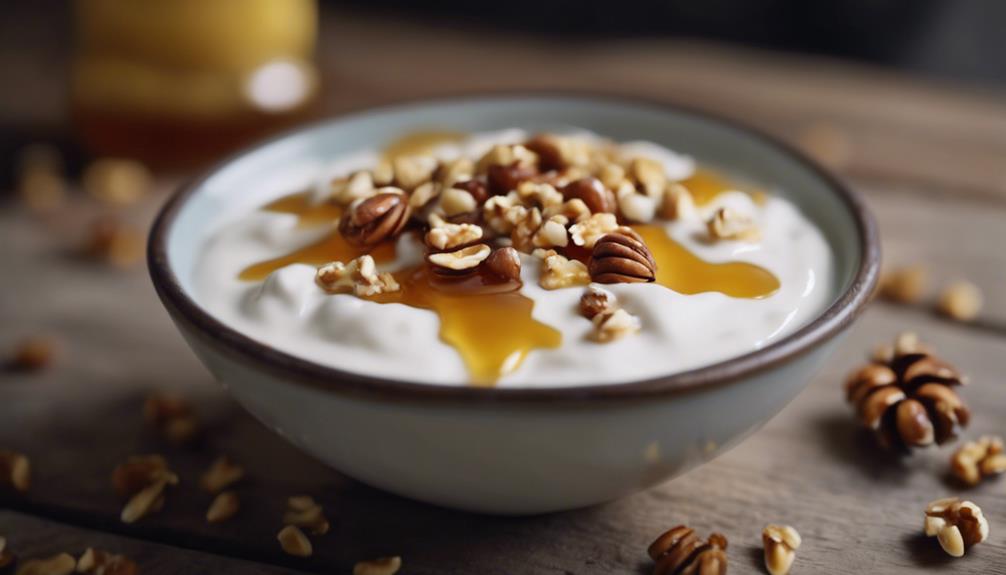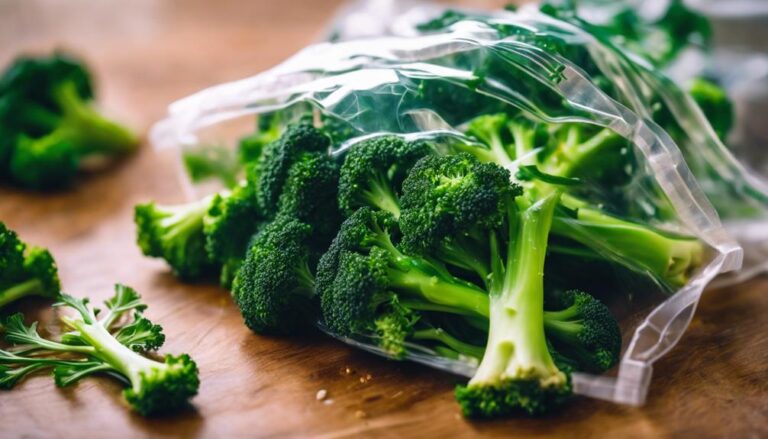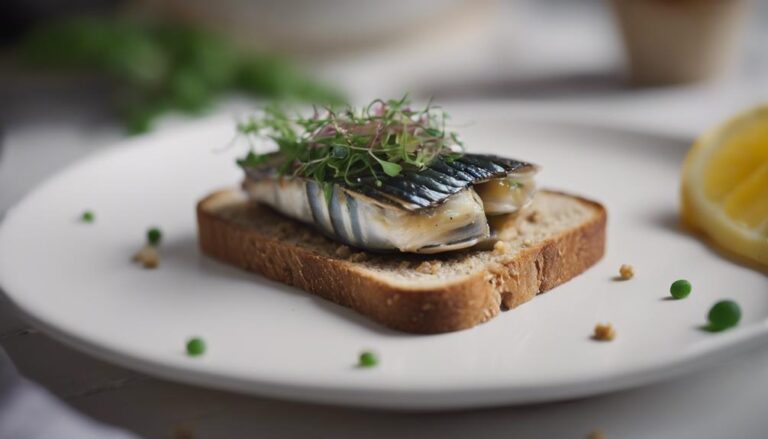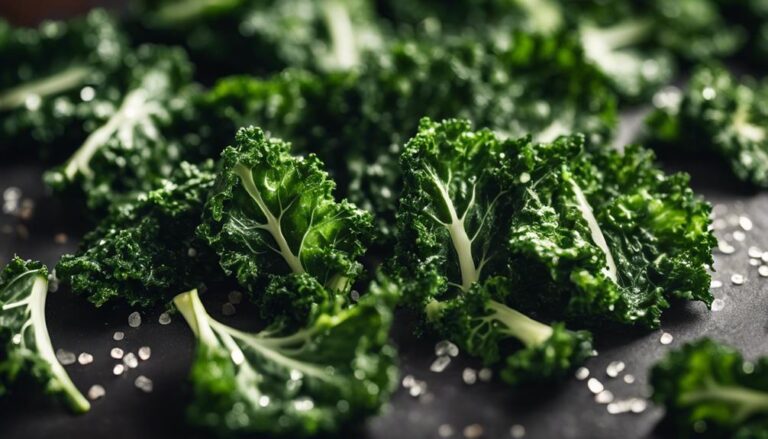Creamy Sous Vide Nordic Yogurt With Honey and Nut
Immerse yourself in the luxurious blend of creamy Sous Vide Nordic yogurt, sweet honey, and crispy nuts, creating a heavenly dessert like no other. The velvety texture of the yogurt combined with the rich flavor of honey and the satisfying crunch of nuts will tantalize your taste buds. This dessert promises a delightful treat that is quick to make and requires no cooking. The nourishing mix of yogurt, nuts, and honey offers a lasting impression of flavors and textures that will leave you craving for more. Get ready to elevate your dessert experience with this indulgent delicacy.
What You Will Learn Here
- Creamy yogurt texture achieved through straining and high-fat milk options.
- Sweetness enhanced with honey drizzle.
- Crunchy texture added with assorted nuts.
- Sous vide method for precise temperature control.
- Harmonious blend of flavors for a delightful dessert.
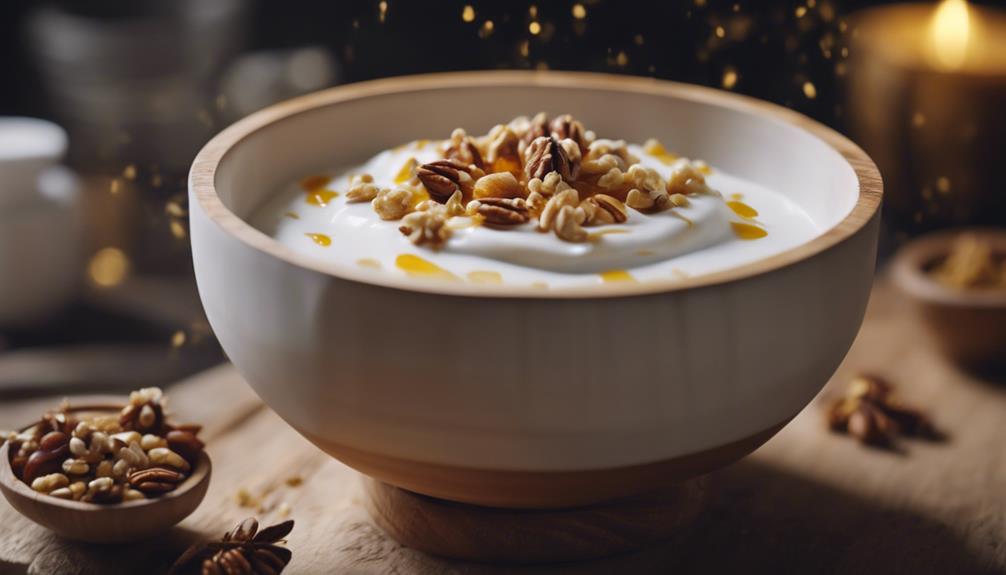
Explore the rich history of yogurt-making in Scandinavia, where ancient traditions from the Viking era have shaped the creamy and tangy flavors of Nordic yogurt.
The ideal climate of the region provides excellent conditions for fermenting dairy products, resulting in a distinct texture and taste that reflect the area's dairy farming heritage.
Over centuries, Scandinavian yogurt-making techniques have evolved, blending cultural significance with modern innovations to create a unique culinary tradition that continues to thrive today.
With a history spanning over a millennium, yogurt-making in Scandinavia has deep-rooted origins that revolve around fermenting milk to craft a lusciously tangy and creamy product.
The traditional methods of yogurt production in the Nordic region have been cherished for generations, with a focus on creating a smooth-textured dairy delight with a mild flavor profile.
The cooler climate of Scandinavia historically played a pivotal role in fostering fermentation practices as a means of preserving dairy products, ultimately leading to the evolution of unique yogurt-making techniques.
Whether enjoyed plain, paired with fruits, or used as a savory topping, Scandinavian yogurt showcases the culinary versatility of the region.
Embracing yogurt as a nutritious staple, Scandinavians appreciate its rich protein content, calcium benefits, and the presence of beneficial bacteria for gut health.
Cultural Yogurt Significance
In Scandinavian culture, the tradition of yogurt-making holds a significant place, reflecting a deep-rooted appreciation for probiotic-rich dairy products and centuries-old fermentation techniques. The creamy yogurt produced in this region is not only valued for its texture but also for its health benefits. The cold climate historically favored fermentation methods like yogurt-making for food preservation, leading to the development of unique variations with ingredients such as berries, herbs, or even fish. Scandinavian yogurt-making techniques have influenced the current trend towards artisanal and probiotic-rich yogurt products, showcasing a blend of tradition and innovation. This cultural significance highlights the intricate relationship between the people of Scandinavia and their love for creamy yogurt.
| Cultural Significance of Scandinavian Yogurt | ||
|---|---|---|
| Rich History | Probiotic Benefits | Influence on Modern Trends |
| Traditional Methods | Unique Ingredients | Blend of Tradition and Innovation |
Historical Yogurt Evolution
Scandinavian yogurt-making traditions trace back to ancient times, rooted in the innovative use of sour milk by the Vikings for dairy preservation, evolving over centuries into the modern sous vide techniques employed today.
The Vikings' method of fermenting milk at room temperature laid the foundation for Nordic yogurt, a practice that has withstood the test of time. In the cold Nordic climate, yogurt became a staple due to its nutritional benefits and extended shelf life.
This rich history of dairy production in countries like Sweden and Norway has continually shaped yogurt styles, leading to the integration of innovative technologies such as sous vide. The marriage of ancient techniques with modern advancements like sous vide has revolutionized yogurt-making, ensuring consistent and creamy results every time.
Key Yogurt Components
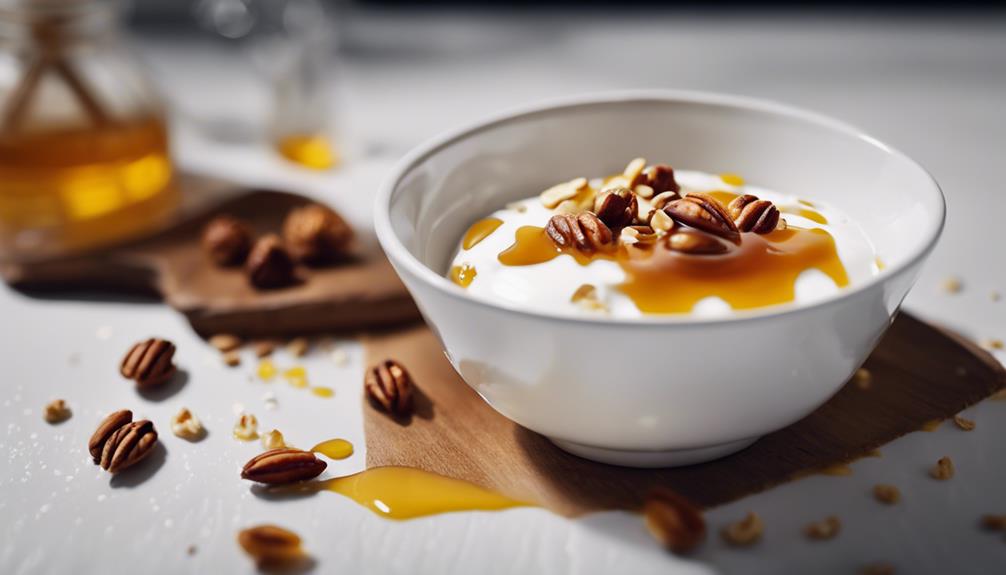
In order to guarantee the successful creation of creamy and tangy yogurt, understanding the key components that contribute to its unique characteristics is essential.
- Live Active Cultures: These beneficial bacteria are vital for the fermentation process, which not only creates yogurt's signature tangy flavor but also helps in developing its texture.
- Full-Fat Dairy: Opting for full-fat dairy when making yogurt results in a richer and creamier taste, elevating the overall flavor profile compared to lower fat alternatives.
- Temperature Control: Maintaining the right temperature during yogurt production is paramount. High heat can damage milk proteins and kill the live cultures necessary for fermentation.
- Straining Techniques: Straining homemade yogurt can yield Greek yogurt, a thicker and creamier variation with a more concentrated taste. This process allows for customization and experimentation with different textures and flavors.
Yogurt Varieties and Flavors
Explore a world of yogurt varieties and flavors with tantalizing options like Nordic Berry Yogurt, Blueberry Lavender Yogurt, and Chia Seed Yogurt.
Each unique blend offers a delightful twist on traditional yogurt, showcasing a fusion of fruits, herbs, and other creative ingredients.
From sweet to savory, these yogurt recipes cater to diverse palates, inviting you to savor a symphony of flavors in every creamy spoonful.
Nordic Berry Yogurt Recipe
Enhance your yogurt experience with the vibrant and invigorating Nordic berry yogurt variation, blending creamy goodness with the tangy sweetness of Nordic berries.
- Nordic berry yogurt combines creamy yogurt with the tartness of Nordic berries, offering a unique flavor profile.
- The addition of Nordic berries provides a balance of sweetness and acidity, creating a revitalizing twist.
- Customize your Nordic berry yogurt with berries like lingonberries, cloudberries, or bilberries for different taste experiences.
- The vibrant colors and flavors of Nordic berries not only enhance the aesthetic appeal but also contribute to a delicious treat that tantalizes your taste buds.
Make your yogurt more exciting by exploring the delightful Nordic berry yogurt variation that adds a burst of fruity goodness to your creamy treat.
Blueberry Lavender Yogurt Recipe
Shifting from the vibrant Nordic berry yogurt, the Blueberry Lavender Yogurt Recipe offers an enchanting blend of sweet blueberries and aromatic lavender, enhancing your yogurt experience with a refined twist.
This delicious recipe combines the antioxidant-rich blueberries with the delicate floral notes of culinary lavender, creating a unique and sophisticated flavor profile. The subtle herbal hint from the lavender adds complexity to the creamy yogurt base, elevating it to a gourmet level.
Perfect for those seeking an invigorating and elegant treat, this Blueberry Lavender Yogurt Recipe is a delightful departure from traditional flavors, providing a burst of fruity sweetness and a touch of floral essence in every spoonful.
Chia Seed Yogurt Recipe
Chia seed yogurt presents a nutritious and flavorful twist to traditional yogurt, incorporating the added benefits of fiber, omega-3 fatty acids, and antioxidants from the chia seeds. When preparing this delectable treat, ensuring you use the right amount of chia seeds is essential. Here's why:
- Nutrient Boost: Chia seeds pack a nutritional punch, enhancing the yogurt with fiber and omega-3s.
- Textural Appeal: The gel-like quality of soaked chia seeds creates a delightful texture in the yogurt.
- Customizable Flavors: Add fruits, honey, or spices to personalize your chia seed yogurt experience.
- Health Conscious Choice: Many opt for chia seed yogurt due to its nutrient-rich profile, making it a smart snack choice.
Yogurt Texture Enhancement Techniques
To elevate the texture of your yogurt, consider techniques like:
- Adding gelatin for firmness
- Draining whey for a thicker consistency
- Incorporating pectin for a creamier mouthfeel
Using higher fat content milk or cream can also result in a silkier texture, while whisking in powdered milk can enhance creaminess. Experiment with these methods to refine and perfect the texture of your homemade yogurt.
Thickness Enhancement Techniques
To enhance the thickness of your yogurt, consider utilizing various techniques such as:
- Straining through a cheesecloth helps remove excess whey, resulting in a thicker consistency.
- Adding powdered milk to the milk mixture increases protein content, contributing to a denser texture.
- Using high-fat milk options like whole milk or cream enhances creaminess and thickness.
- Incorporating pectin or gelatin during the heating process aids in thickening the yogurt during preparation.
- Allowing for additional straining in the refrigerator post sous vide preparation helps improve thickness and consistency, giving you a delightful creamy yogurt to enjoy.
Creaminess Boosting Methods
For a lusciously creamy yogurt texture, consider enhancing it with gelatin to provide structural stability and a rich, stable consistency. Adding gelatin to your yogurt mixture can help achieve a velvety smooth texture that feels indulgent on the palate.
Next time you make yogurt, try incorporating heavy cream or condensed milk to up the fat content, resulting in a more decadent and creamy end product. Opting for a higher milk fat percentage like whole milk or cream can also contribute to a silkier consistency that's bound to please your taste buds.
Additionally, when straining the yogurt through a cheesecloth or coffee filter, you can remove excess whey and thicken the texture, further boosting its creaminess. Give these methods a go to elevate your yogurt game to new levels of creaminess.
Texture Refining Tricks
Enhancing the creaminess of your yogurt goes beyond just adding ingredients; it involves employing texture refining tricks that can elevate your homemade yogurt to a whole new level of decadence and satisfaction.
Straining the yogurt through cheesecloth can enhance its thickness and creaminess, while adding a touch of powdered milk can improve its overall texture.
Opting for a higher fat content milk will result in a richer and smoother yogurt experience. For a tangier flavor and firmer texture, allow the yogurt to ferment longer.
To achieve a stable and velvety texture, consider incorporating pectin or gelatin into the mixture. Experiment with these techniques to find the perfect texture that suits your preferences.
For more personalized tips, feel free to reach out via email.
Final Thoughts
In conclusion, enjoy the harmonious blend of creamy yogurt, sweet honey, and crunchy nuts that make this Sous Vide Nordic Yogurt dessert a delectable and nutritious choice for any occasion.
This dessert not only satisfies your sweet cravings but also offers a delightful treat, making it perfect for those hot summer days.
The ease of assembly adds to its appeal, as you can quickly put together this delightful dish without the need for any cooking.
By combining the cooling properties of yogurt, the healthy fats found in nuts, and the antioxidant benefits of honey, this dessert becomes a well-rounded option that not only pleases your taste buds but also nourishes your body.
Whether you indulge in it as a light after-dinner treat, a satisfying snack, or serve it to guests, this creamy yogurt with honey and nuts will surely leave a lasting impression with its delightful mix of flavors and textures.
Frequently Asked Questions
What Is the Best Temperature to Sous Vide Yogurt?
For the best sous vide yogurt, you should aim for a temperature accuracy around 105°F/40°C. This guarantees a creamy texture and ideal fermentation. Consistent temperature is key for those live active cultures to thrive and create the desired consistency.
Why Is My Homemade Yogurt Not Creamy?
If your homemade yogurt isn't creamy, it could be due to factors like milk fat content, fermentation time, or straining. Adjusting these elements and ensuring proper temperature control can help improve your yogurt texture.
Can You Put Honey in Greek Yogurt?
Yes, you can put honey in Greek yogurt. The honey pairing adds natural sweetness and antioxidants, balancing the tangy yogurt. Customize your dessert with a luscious touch of honey, creating a flavorful indulgence to suit your taste.
Does Cooking Yogurt Longer Make It Thicker?
Cooking yogurt longer can indeed make it thicker. The extended cooking time allows for more lactose conversion into lactic acid, resulting in a denser consistency. However, be mindful of balancing this with taste preferences to achieve the perfect yogurt consistency.
Conclusion
Indulge in the velvety smoothness of creamy sous vide Nordic yogurt, perfectly balanced with the sweetness of honey and the crunch of nuts.
This decadent treat not only satisfies your taste buds but also provides a rich source of probiotics and nutrients.
Elevate your yogurt experience with this luxurious combination that will leave you craving for more.
Embrace the Nordic tradition of yogurt-making and savor every spoonful of this delightful creation.
